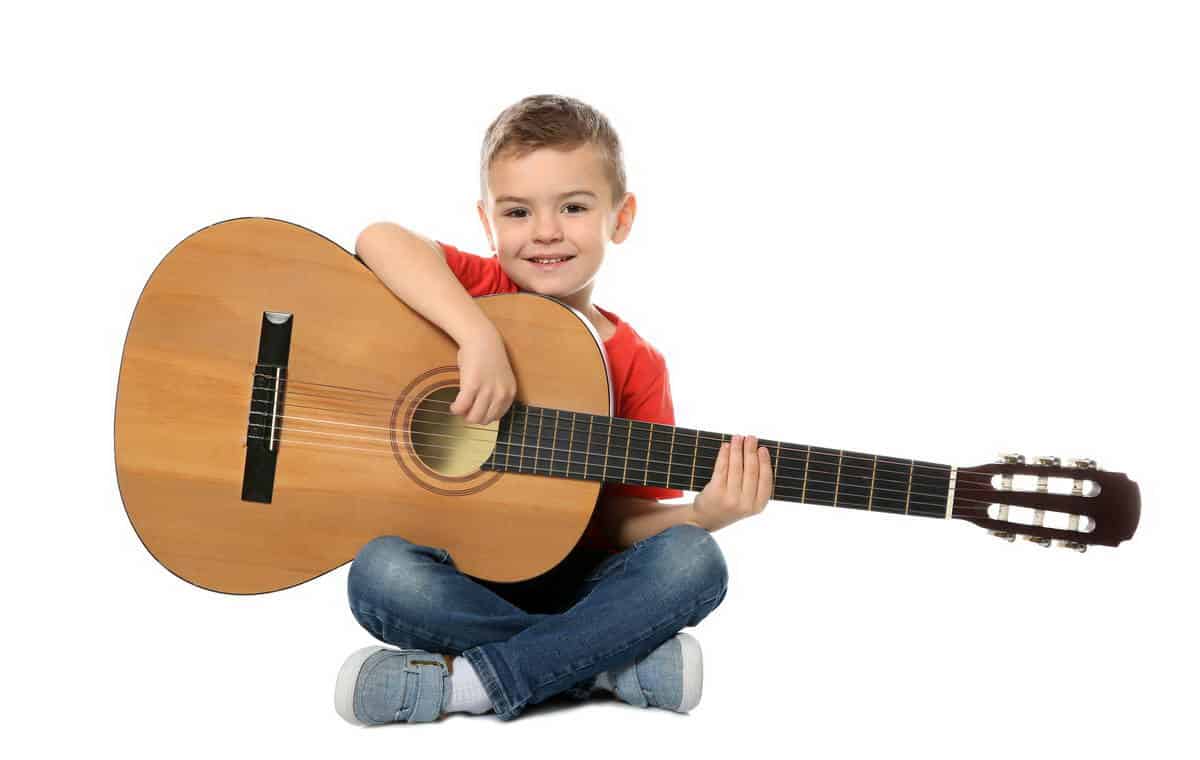Your child's journey into the world of learning guitar and music can be an exciting as well as challenging one. Like every parent, you want your child to start the adventure on the right foot. You won't be helping their cause by putting usual size guitars into their hands. Different guitar sizes are available in the market, and it is essential to pick the correct kid-size guitar for them.
Young kids with small hands and arms will not be able to reach the end of the neck of a regular full-size guitar. It is also difficult for them to wrap their hands around the neck to play. Starting to play on a wrong-sized guitar can be frustrating, leading to slow progress and development of wrong techniques.

Kid with oversized acoustic guitar

Kid with correct guitar size
Hence it is very important to consider the correct size of the guitar and neck when buying a guitar for your child. Good news is that there are many different guitar sizes available in the market to suit your needs. But sometimes more options can make your task of selecting a suitable guitar for your kid even more daunting.
This article will help you select the correct kid-size guitar depending on their age, size and ability.
Introduction To Guitar Sizes.
The size of any small body guitar can be measured in two ways, based on overall length or scale length. Overall length is the total length of the guitar from the tip of the headstock to the edge of the guitar body top.
The overall length of the standard full-size guitar can vary from 38" to 42" for different types of guitars. Three major elements are determining the total length - Body, neck and headstock. Either of these elements can be reduced to reduce the overall length of the guitar.
In travel guitars, the body size is significantly reduced, keeping the neck size the same. What affects a child's ability to play the guitar properly is the length of the neck. Hence overall length is not a good measure to judge the suitability of a guitar for a kid.
Scale Length
Age and height decide the suitable length of the neck for your child. That's where another measure of length, known as scale length, comes in. The scale length of any guitar is the distance between the bridge and the nut. The scale length is, in effect, the length of the string that vibrates on plucking.
The length between bridge and nut is not same for all the strings of the guitar, because strings have different starting points to compensate for intonation. The better way to calculate scale length is to find the distance between the front edge of the nut and centre of the 12th fret and double it.
Shorter scale length invariably translates to a shorter neck. A small difference in scale length can give a completely different feel while playing. Guitars with different overall length can have the same scale length.
Guitar Sizes
Common sizes for Acoustic guitars are 1/4 size, 1/2 size, 3/4 size and full size with 1/8 size and 7/8 size also being available.
Other sizes are scaled-down versions of the full-size guitar. Common expectations based on the nomenclature used will be that ½ size guitar is half the size of the full-sized version. It is not so. The naming system can be very misleading in this regard. Names are just a way to simplify the options and give a basic idea which guitar is bigger.
Common overall lengths for different size and types of guitars are
Guitar Size | Classical Guitar | Acoustic Guitar | Electric Guitar | Bass Guitar |
|---|---|---|---|---|
¼ | 31” | 32” | 31” | 36” |
½ | 33” | 36” | 33” | 39” |
¾ | 36” | 38” | 35” | 42” |
Full Size | 38.0 - 40.0” | 40.0 - 42.0” | 38.0 - 40.0” | 43.0 - 46.0” |
Table showing size of the guitar, range of overall length and scale length for classical guitar with nylon strings is shown below.
Guitar Size | Overall Length in cm | Overall Length in inches | Scale Length in cm | Scale Length in inches |
|---|---|---|---|---|
¼ | 73.3 - 80.0 cm | 28.9 - 31.5” | 44.0 - 48.6 cm | 17.3 - 19.1” |
½ | 83.8 - 86.0 cm | 33.0 - 33.9” | 52.1 - 57.8 cm | 20.5 - 22.8” |
¾ | 89.5 - 92.2 cm | 35.2 - 36.3” | 57.2 - 59.1 cm | 22.5 - 23.3” |
⅞ | 93.3 - 94.0 cm | 36.7 - 37.0” | 61.0 - 61.9 cm | 24.0 - 24.4” |
Full Size | 96.5 - 101.6 cm | 38.0 - 40.0” | 63.0 - 66.4 cm | 24.8 - 26.1” |
Chart for Acoustic guitar with steel strings is shown below
Guitar Size | Overall Length in cm | Overall Length in inches | Scale Length in cm | Scale Length in inches |
|---|---|---|---|---|
¼ | 73.3 - 80.0 cm | 28.9 - 31.5” | 48.3 - 48.6 cm | 19.0 - 19.1” |
½ | 83.8 - 90.2 cm | 33.0 - 35.5” | 54.9 - 57.8 cm | 21.6 - 22.8” |
¾ | 87.6 - 93.0 cm | 34.5 - 36.6” | 58.4 - 59.1 cm | 23.0 - 23.3” |
⅞ | 92.4 - 99.7 cm | 36.4 - 39.3” | 59.2 - 62.9 cm | 23.3 - 24.8” |
Full Size | 101.6 - 106.7 cm | 40.0 - 42.0” | 61.0 - 72.7 cm | 24.0 - 29.0” |
Guitar Sizes For Different Ages
We have guided the selection of the type of guitar for beginners in our articles
- Classical Vs Acoustic Guitar – A Helpful Guide
- Acoustic Vs Electric Guitar – The Best Guitar For Beginners
The chart given below will guide you in the selection of correct guitar size for your child, depending on his age and height.
Guitar Size | Overall Length in inches | Height of the Child | Age of the Child |
|---|---|---|---|
¼ | 30” | 1.04 to 1.14 m | 4 to 6 years |
½ | 34” | 1.14 to 1.30 m | 6 to 8 years |
¾ | 35.5” | 1.30 to 1.42 m | 8 to 10 years |
⅞ | 38” | 1.44 to 1.60 m | More than 10 years |
Full Size | 41” | More than 1.60 m | More than 12 years |
The above chart only provides the guidelines, and the right size may vary from child to child. It is recommended that
You will find more options for kid-size guitars in Classical guitars. Classical Guitars are lightweight, and nylon strings are softer and comfortable for children to play.
Electric guitars are next best as the strings are thin and with lower tension compared to acoustic ones.
Neck Width And Radius
Another factor that can have an impact is the width of the neck at the nut. This width gives us the idea of fretboard widths of different guitars. The wider fretboard has both advantages and disadvantages.
Wider fretboard results in increased distance between the strings, making it easy to finger notes. But it also makes it harder for kids with small hands to get around the neck.
The radius of the back of the neck gives an idea about the thickness of the neck. Kids with small hands will prefer guitars with small neck radius.
Classical guitars have wider necks. So selecting appropriate guitar with correct scale length and proper neck width and radius is very important when buying a guitar for a child.
More: 1/2 size acoustic guitar
More: 3/4 size acoustic guitar
More: 7/8 size acoustic guitar
More: Electric Guitar for Kids
Conclusion
With so many choices available, it can be quite overwhelming to choose the correct kid size guitar to suit the age and height of your kid. We hope that the guidelines and information have given you enough insights to decide what type of guitar you should buy for your child. We will be happy to answer any queries or doubts that you have.

